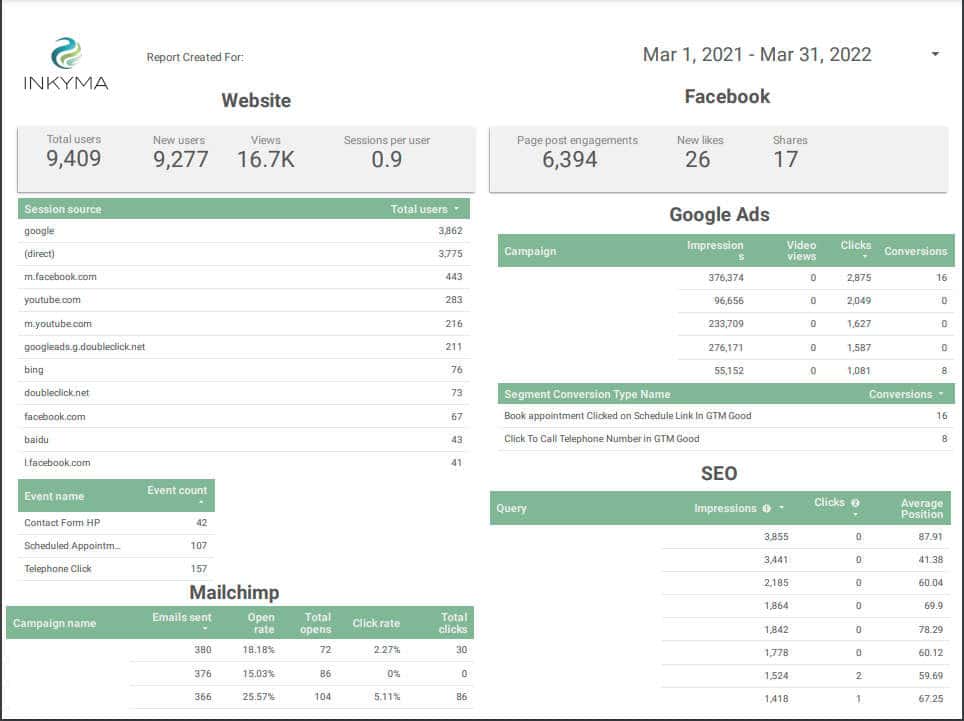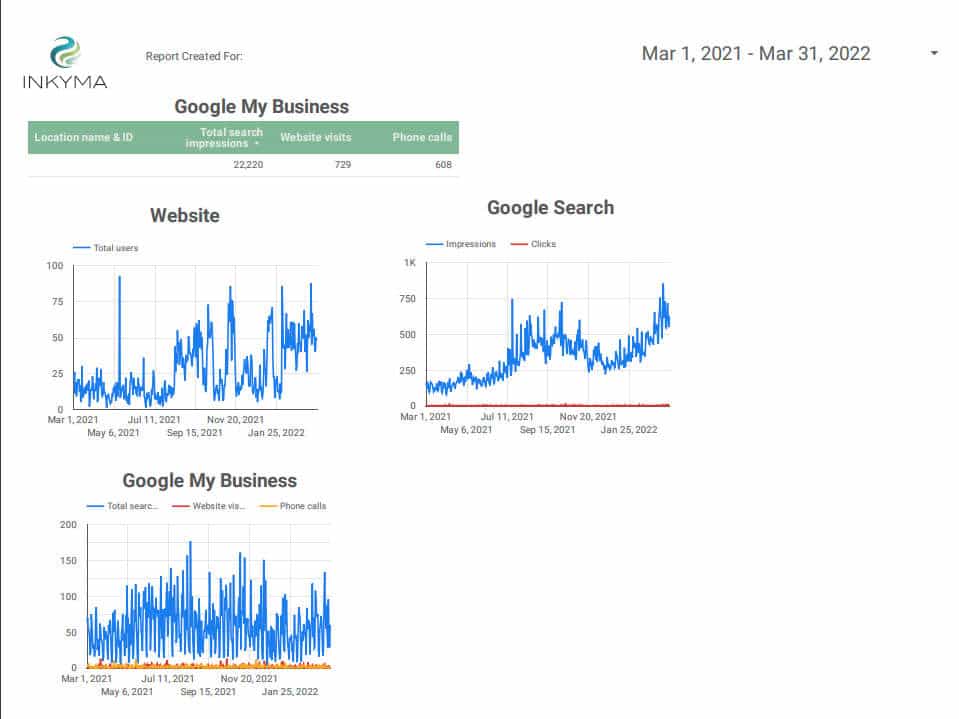
In our article 7 Marketing Report Objectives To Increase Sales we talked about retaining current customers to help drive sales growth in a business. If you enjoy helping your customers and are always looking for ways to improve your customer service then a customer retention objective is a great place for you to start working on adding revenue to your business
As a general rule creating a marketing analytics process is the easiest way to get to your goal of having better customer relationships. Here is the outline of a simple process you can follow to get started with getting more business from your existing customers:
- Define The Objective
- Gather The Data
- Analysis
- Make Changes Based On Your Findings
- Reanalyze The Metrics
We will cover in detail what is needed for each step of the process so you can create your own organized process that is tailored to your business and your objectives. We will also share an industry example of what this could look like to help deepen your understanding of how the process works and be consistent in your approach to customer service.
Customer Relationships As A Marketing Objective
Taking care of your customers is one of the most authentic ways to market your business. Happy customers tend to buy more from you and on a more frequent basis. They also refer their friends and families to you because you have created a relationship of support and trust with them.
The first step in building relationships with your customer is to understand them better and to really know what they want and need from your business.
How To Know If Customers Are Happy
How do you know if your customers are happy with your product and services? You can look at your data to see how often repeat customers buy from you but you are better off just asking them. Depending on the type of business you run there are many ways to have this conversation with your customers:
Weekly, monthly or quarterly meetings – these don’t have to be long meetings 10min to a half hour at most. Just so you can check-in and see how things are going and if there is anything they need or you can improve upon for them.
Surveys – you can send periodic surveys to customers to get specific data back about your business, your products, and services. Just note if they give you suggestions for improvements make sure you acknowledge them and thank them for the input even if you do not decide to act on the information.

Ask for a review – Google reviews do amazing things for your online presence. Potential customers use them as part of their decision-making process and google uses them as part of the algorithm for SEO. The more recent 5-star reviews you have the better your SEO will be overall.
Every time a service is completed or a purchase is made you can trigger an automated email series in your email CRM system to ask the client how things went with their recent purchase and if they have any questions or concerns. If they are happy you can ask them to leave you a google review. Make sure you embed your Google Review Link (found in your google my business listing panel) in the email to make it easy for them to leave you a review.
This type of automation is easy to set up if you are using Mailchimp or Constant Contact as your email marketing system. These are the two systems we use for helping our clients.
Customer Relationship Marketing Analytics Process
If you set up improving customer relationships as a marketing objective so that you can sell more to existing customers you need to create a marketing analytics process to track your progress toward the customer relationship goal. Having a marketing analytics process is the easiest way for you to track your progress as this type of goal takes time but the long-term impact on your business is well worth the time and effort you put into supporting your customers.
Define The Objective
Define your objective using SMART Goals. we detail what smart goals are in our article 7 Marketing Report Objectives To Increase Sales and we found a great resource for you to learn more about this – SMART Criteria: Become more successful by setting better goals (Management & Marketing)
An example of a SMART goal for improving customer relationships is:
S – Improve customer satisfaction for our products and service.
M – Take a customer satisfaction survey now and in 6mths after specific efforts have been implemented see how we have improved
A – Add a customer liaison position to the business to manage this
R – Request testimonials from customers that also ask how their experience is and ask for feedback. Have the liaison capture all feedback, good and bad. Create a plan of what new things need to be implemented
T – After gathering data for 2 months, pick which items to take action on and implement. Resurvey customers 6 months after implementation.
Gather The Data
The creation of a SMART goal helps you define what you are going to do. You also need to define what data points you will gather and track as part of the marketing analytics process. You want to ensure that you get all the data you need for the full-time frame of your goal.
Often we see businesses set SMART goals but then they don’t figure out the necessary data points before they implement their marketing tactics. When they want to look at or measure how the campaigns are doing they don’t have the right data and can’t make decisions on how to move forward or how to make changes.
Data gathering is one of the most important steps in the process, good data gives you the answers you are looking for and the information you need to make informed decisions about your marketing program.
Analysis
Many businesses don’t look at their data because it’s not easy to view. As part of your marketing analytics process, you want to create a quick and easy way to see your data. It takes a little time, in the beginning, to set up a good data report but when done correctly reviewing it and understanding your data doesn’t take long at all.
Usually, each marketing goal has data from multiple campaign sources. For example google analytics for website and online purchase data, email CRM for email open and click-through rates. Google My Business for reviews. You can look at these sources individually or you can create a single dashboard report view using Google Data Studio and a data aggregator that pulls all this data together in one place.
We use Supermetrics for data aggregation in Google Data Studio. Supermetrics has over 70 different data connectors to choose from. Here is an example of what one of our basic reports looks like in Google Data Studio


As part of the marketing analytics process, you select all your data points before you begin your campaigns. These data points you have selected are what goes in your Google Data Studio report so you can track them.
Make Changes Based On The Data
The next step is to create and implement your marketing campaigns based on your goals. Once your campaigns are running you want to keep track of them and how they are doing right from the beginning but don’t make changes right away. Marketing campaigns take a while to collect enough data so that you can decide if you need to make a change.
We recommend that you let all your campaigns run for at least a month before you make a change, that way you have enough data to make a decision with. Smaller amounts of data like one sale or one day’s worth of email opens won’t give you a full picture. The sale or the day you pick could be outside of the normal trends and give you false positives or false negatives results.
There are many types of events that can create spikes in trends. Holidays, news reports, and stock market changes are just a few things that influence consumers’ habits without them even realizing it. Specific announcements or events in your industry can also have an effect on your campaigns.
An example is you could see a one-day spike in email sign-up because you are a keynote speaker at an event. After hearing you speak 100 people sign up for your newsletter. This is not an indicator that you will start to see 100 new sign-ups every day as a new trend in your data. This one is easy to spot but sometimes these spikes are not always so easy to figure out why or how they happened.
The only time you want to make an immediate change in your marketing campaigns is if you see errors in content or delivery. Errors either in targeting audience creation, language, or broken links can create a negative impact on campaign results that skew your data. If the campaigns are not working as intended then you will not get the results you are looking for even if the original concept is sound. Your execution of the campaign has to match the campaign outline.
As part of your goal setting, you define the length of time that a campaign needs to run before you determine the campaign’s effectiveness. Once you have hit your time milestone for the campaign and look at the data you want to determine what is working and what is not working.
For things that are working well, you can decide whether or not you want to optimize them to make them better. This could be increasing your budget for a digital ad campaign or sending more email offers to the customers that tend to buy from you more frequently. You want to make these changes small and slowly over time so you don’t reverse the progress you have made. More is not always better and sometimes too much is not a good thing.
If certain parts of your campaign didn’t work try to figure out why. Was the audience targeting wrong? Did your language not resonate with the customer? This is where you can start doing A/B testing for language, audience, and images to see what could work better to get the results you are looking for.
Inkyma’s Marketing Strategy did a podcast episode that talks about A/B testing. A/B Testing To Convert More Leads Into Customers.
Reanalyze The Metrics
After making changes to your marketing campaigns based on the initial data results you want to look at your data again to see if your changes improved or worsened your results.
You may have decided to add new tactics to your overall campaign. Ensure you have defined the specific data points to track these new tactics. Also, take this time to decide if you did capture all the right data points for your campaigns.
In Google Data Studio you can add comparison trends to your report with this the data can show if something is better or worse than the previous time frame. For example, if you are tracking website visits to your contact form because you are driving traffic there you can see the total number of visits for 30 days with an indicator of whether this is higher or lower than the previous 30 days.
We call this the rinse and repeat part of the campaign as you will go through the main cycles of looking at data, making changes to the campaign, and looking at the data again. But this is not the only reason to keep reanalyzing your data as part of your marketing analytics process.
The other reason to look at the metrics is to see what impact changes in the economy and the marketplace have on the effectiveness of your campaigns. You could have a campaign that has worked great for several years and then a social change comes that makes your campaign feel out of touch or irrelevant in the current circumstances.
The best example of this is the COVID pandemic. When businesses had to shut down and we had to social distance, campaigns that were relevant just days before the shut down seemed tone def and the business looked unsympathetic and uncaring. This can happen anytime to a much smaller degree so make sure you are attuned to what is going on in the world when you are looking at your metrics.
Service Industry Example
Examples make it easier to understand the marketing analytics process and inspire ways for you to implement your own. Here I’m going to share a service industry example for improving customer relationships as a marketing goal and the data points to track.
Petcare Services

Petcare companies offer a wide variety of services to their customers. The perfect customer is one that uses at 3 least of their services on a daily weekly or monthly basis. They will typically come in for one type of service say dog grooming or kennel stays and then add on the others like doggy daycare or pet-sitting once they have come to trust the business.
The goal of better customer relationships is key to getting the single service client to start using all the different offerings of the business.
| Marketing Campaign | Data Collection Points | Things to Think About |
| Customer Satisfaction Survey | Survey responses Free Text Comments | For frequent services (daily and weekly) put customers on a quarterly schedule for the survey. Asking for feedback too frequently can get annoying. Offering them a free one-time service or product as an incentive to get higher participation rates. |
| Request A Review Email Series | Emails with concerns Google Reviews and increase of reviews over time | Ask for google reviews with a link to your review page Before asking for the review ask them to reach out if they have questions or concerns that you can address privately. |
| Special Offer To Customers Refer | Track where new customers and leads come from | Let your customers know that you want referrals and also if you are providing an incentive for the refer, like a free dog grooming |
| Welcome Email Series | Email open and click-through rates | Automated email series when a new customer is added to the business. This is a thoughtful way to make sure all new customers are welcomed and you start email engagement as quickly as possible to ensure later emails are read. |
I hope you found this article helpful in securing your business so you can stay focused on your growth goal which always includes marketing. Feel free to reach out via chat if you have any questions. We are always happy to answer questions. If you want our content delivered to your inbox Sign up for our newsletter. You get great content and exclusive offers by being a member.
If you like this article, consider sharing it with other business owners you know. Use the sharing links below.






